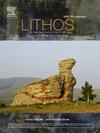Zircon U-Pb ages, trace elements, and Hf isotopes establish a genetic link between volcanic ash beds and porphyritic intrusions during early Silurian in the South China Block
IF 2.9
2区 地球科学
Q2 GEOCHEMISTRY & GEOPHYSICS
引用次数: 0
Abstract
The provenance of the Late Ordovician to Early Silurian volcanic ash beds (VABs) in the South China Block (SCB) remains debated. In this study, we provide new zircon U-Pb age, trace element, and Hf isotope data of bentonites, crystal tuffs, and porphyritic intrusions from the Longmaxi Formation of the Dabashan area in the northern margin of the SCB with a view to investigate the composition, tectonic setting, and source of their parent magmas. The zircon U-Pb ages show that the volcanic eruption and magma emplacement occurred in the Early Silurian (ca. 440–434 Ma). The zircon trace element compositions are consistent with A-type parent magmas formed in intraplate extensional settings. The positive εHf(t) values (+1.7 to +6.9) of zircon indicate an enriched mantle source for the magma, with possible crustal input. The similar U-Pb ages, trace element compositions, and εHf(t) values of zircon grains from VABs and porphyritic intrusion in the Dabashan area suggest that their parent magmas shared similar sources. These A-type parent magmas could have originated in intraplate extension settings on the passive margin of the northern SCB during the subduction of the Proto-Tethys Ocean towards the North Qinling Terrane. Our results suggest that the Paleo-Tethys oceanic basin did not open before the Early Silurian (ca. 434 Ma) in the Dabashan area.
求助全文
约1分钟内获得全文
求助全文
来源期刊

Lithos
地学-地球化学与地球物理
CiteScore
6.80
自引率
11.40%
发文量
286
审稿时长
3.5 months
期刊介绍:
Lithos publishes original research papers on the petrology, geochemistry and petrogenesis of igneous and metamorphic rocks. Papers on mineralogy/mineral physics related to petrology and petrogenetic problems are also welcomed.
 求助内容:
求助内容: 应助结果提醒方式:
应助结果提醒方式:


